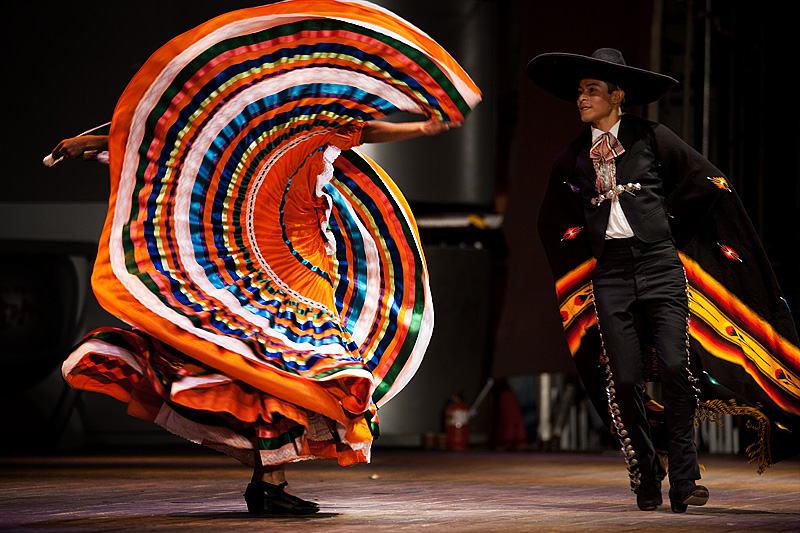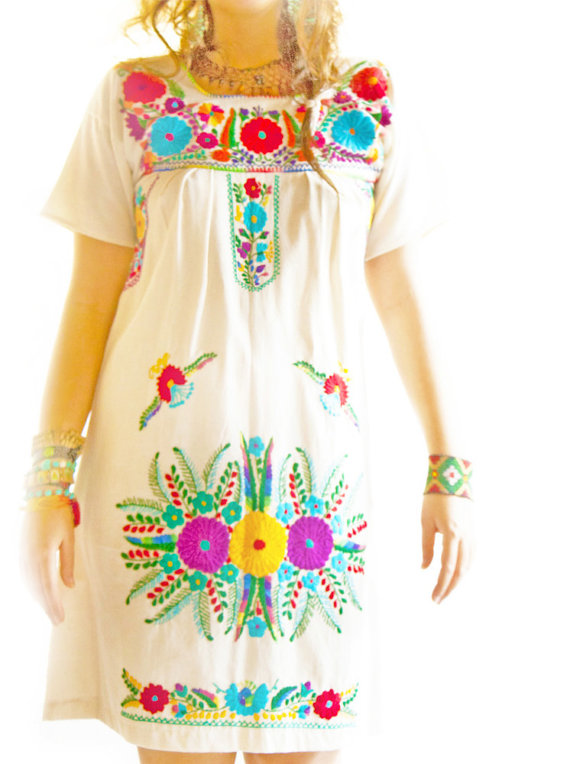Source(Google.com.pk)
Traditional Mexican Dresses Biography
Authentic Mexican clothing has a long tradition in the indigenous cultures of Mexico, but it has also adapted through time. Women clothing has changed less than clothing for men, and many more indigenous women in Mexico today still use traditional clothing. The only exception may be in the use of huaraches or Mexican footwear. Women has adapted to the more modern styles while men still use the authentic sandals.
In pre-Hispanic times, women wore items such as enredo, quechquémitl and huipil. Later when the Spaniards arrived, women started to use European style blouses with some of the same embroidery. Traditional Mexican clothing for men were called tilma and maxtlatl, which were replaced by European style shirts and pants.
Today, traditional Mexican clothing is gaining popularity around the world, promoting Mexican culture, and art.
The symbols made by knitting and embroidery are fundamentally simple: triangles, rectangles, rhombuses, zigzag lines, stepped borders, helical patterns, crosses, etc.
Typical Mayan Pattern
For example, the triangle is widely used forming rhombuses in Huichol art. Also, flowers and stars with eight tips are applied in embroideries from the Otomís, Nahuas, Huastecos and Huichols. The stepped borders design has a distinguishable pre-Hispanic origin.
Nature and the human figure are the main inspiration emblems in most of the Mexican embroidery and knits.
The arrival of the Spanish conquistador brought Christian symbols such as the cross, the Virgin Mary, saints, angels and others. The Mexican national symbol with an eagle on a prickly pear cactus is now famous too.
In the Purepecha region in near the city of Morelia, textiles are embroidered with popular phrases or significant dates.
Mexican traditional clothing is getting popularity due to its simplistic beauty. Its symbols, art and history enrich it and make it even more interesting.
There are beautiful Traditional Mexican dress designs in every corner of Mexico and they are used in religious, patriotic or cultural celebrations. Here are some examples:
Tabasco Traditional Dress
The typical dress from Tabasco is usually a skirt using a flower print fabric, a white blouse, and embroidery figures in the collar and sleeves. This one in particular is a modern design from the Mayan Chontal indigenous women. They also like to wear sophisticated hairstyle with flowers. Their clothing has evolved through history; in the past before the Spanish arrived, they had a simpler apron and top. With the textile industry developing, they started to create their own textile designs
Michoacan Traditional Dress
Michoacán is the state of Mexico where Purepechas have lived for a long time, in the land around Lake Patzcuaro. Women use sophisticated clothing: A skirt with a pattern, a long blouse with embroidery at the bottom and around the neck, a belt strapped on the back, and usually a rebozo. Blouses with more embroidery are used in special celebrations. Aprons are also typically used and they also have nice cross stitch embroidery decoration.
Campeche Traditional Dress
Campeche is a state in the Yucatan Peninsula where the Mayan civilization once flourished. The cloth in Campeche is different than the typical Mayan clothing found in the surrounding areas due to the Spanish influence. This city was a walled city during the Spanish colonization and was an important commerce port. The dress used a huipil blouse usually with black thread embroidery around the square collar. The embroidered design had the resemblance of onions and pumpkin flowers. The skirt was ankle long usually made out of fine Spanish print fabric. They also use the typical rebozo or headscarf.
Huipil
The huipil (pronounced "wee-peel") is a sleeveless, tunic-like garment. As with many other cultures that use garments to identify their specific areas of origin, the distinctive design on a huipil can distinguish the community that the wearer belongs to. The designs may also convey the wearer's marital status or personal beliefs. A ceremonial huipil is one worn by wives of religious figures in the community, as well as statues of saints. Huipils are worn by children, teenagers and adults alike.
Quechquémitl
Worn most commonly as part of a dressy ensemble for a party or other special occasion, the quechquémitl consists of two rectangular pieces of cloth woven to resemble a small poncho. They're made with everything from wool to cotton, and may be embroidered with animals, floral prints and graphic designs. Depending on the woman's community, the quechquémitl may be made with a different technique. For example, in Veracruz the garment is constructed of gauze and is worn on the head instead of on the body.










Traditional Mexican Dresses Biography
Authentic Mexican clothing has a long tradition in the indigenous cultures of Mexico, but it has also adapted through time. Women clothing has changed less than clothing for men, and many more indigenous women in Mexico today still use traditional clothing. The only exception may be in the use of huaraches or Mexican footwear. Women has adapted to the more modern styles while men still use the authentic sandals.
In pre-Hispanic times, women wore items such as enredo, quechquémitl and huipil. Later when the Spaniards arrived, women started to use European style blouses with some of the same embroidery. Traditional Mexican clothing for men were called tilma and maxtlatl, which were replaced by European style shirts and pants.
Today, traditional Mexican clothing is gaining popularity around the world, promoting Mexican culture, and art.
The symbols made by knitting and embroidery are fundamentally simple: triangles, rectangles, rhombuses, zigzag lines, stepped borders, helical patterns, crosses, etc.
Typical Mayan Pattern
For example, the triangle is widely used forming rhombuses in Huichol art. Also, flowers and stars with eight tips are applied in embroideries from the Otomís, Nahuas, Huastecos and Huichols. The stepped borders design has a distinguishable pre-Hispanic origin.
Nature and the human figure are the main inspiration emblems in most of the Mexican embroidery and knits.
The arrival of the Spanish conquistador brought Christian symbols such as the cross, the Virgin Mary, saints, angels and others. The Mexican national symbol with an eagle on a prickly pear cactus is now famous too.
In the Purepecha region in near the city of Morelia, textiles are embroidered with popular phrases or significant dates.
Mexican traditional clothing is getting popularity due to its simplistic beauty. Its symbols, art and history enrich it and make it even more interesting.
There are beautiful Traditional Mexican dress designs in every corner of Mexico and they are used in religious, patriotic or cultural celebrations. Here are some examples:
Tabasco Traditional Dress
The typical dress from Tabasco is usually a skirt using a flower print fabric, a white blouse, and embroidery figures in the collar and sleeves. This one in particular is a modern design from the Mayan Chontal indigenous women. They also like to wear sophisticated hairstyle with flowers. Their clothing has evolved through history; in the past before the Spanish arrived, they had a simpler apron and top. With the textile industry developing, they started to create their own textile designs
Michoacan Traditional Dress
Michoacán is the state of Mexico where Purepechas have lived for a long time, in the land around Lake Patzcuaro. Women use sophisticated clothing: A skirt with a pattern, a long blouse with embroidery at the bottom and around the neck, a belt strapped on the back, and usually a rebozo. Blouses with more embroidery are used in special celebrations. Aprons are also typically used and they also have nice cross stitch embroidery decoration.
Campeche Traditional Dress
Campeche is a state in the Yucatan Peninsula where the Mayan civilization once flourished. The cloth in Campeche is different than the typical Mayan clothing found in the surrounding areas due to the Spanish influence. This city was a walled city during the Spanish colonization and was an important commerce port. The dress used a huipil blouse usually with black thread embroidery around the square collar. The embroidered design had the resemblance of onions and pumpkin flowers. The skirt was ankle long usually made out of fine Spanish print fabric. They also use the typical rebozo or headscarf.
Huipil
The huipil (pronounced "wee-peel") is a sleeveless, tunic-like garment. As with many other cultures that use garments to identify their specific areas of origin, the distinctive design on a huipil can distinguish the community that the wearer belongs to. The designs may also convey the wearer's marital status or personal beliefs. A ceremonial huipil is one worn by wives of religious figures in the community, as well as statues of saints. Huipils are worn by children, teenagers and adults alike.
Quechquémitl
Worn most commonly as part of a dressy ensemble for a party or other special occasion, the quechquémitl consists of two rectangular pieces of cloth woven to resemble a small poncho. They're made with everything from wool to cotton, and may be embroidered with animals, floral prints and graphic designs. Depending on the woman's community, the quechquémitl may be made with a different technique. For example, in Veracruz the garment is constructed of gauze and is worn on the head instead of on the body.
Traditional Mexican Dresses

Traditional Mexican Dresses

Traditional Mexican Dresses

Traditional Mexican Dresses

Traditional Mexican Dresses

Traditional Mexican Dresses

Traditional Mexican Dresses

Traditional Mexican Dresses

Traditional Mexican Dresses

Traditional Mexican Dresses

Traditional Mexican Dresses
No comments:
Post a Comment